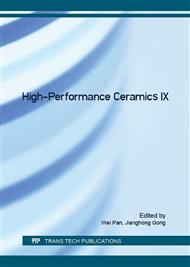[1]
E. Evgenidou, K. Fytianos, I. Poulios, Semiconductor-sensitized photodegradation of dichlorvos in water using TiO2 and ZnO as catalysts, Appl. Catal. B: Environ. 59 (2005) 81-89.
DOI: 10.1016/j.apcatb.2005.01.005
Google Scholar
[2]
J.S. Lee, K.H. You, C.B. Park. Highly photoactive, low band gap TiO2 nanoparticles wrapped by graphene, Adv. Mater. 24 (2012) 1084-1088.
DOI: 10.1002/adma.201104110
Google Scholar
[3]
H. Choi, E. Stathatos, D.D. Dionysiou, Sol–gel preparation of mesoporous photocatalytic TiO2 films and TiO2/Al2O3 composite membranes for environmental applications, Appl. Catal. B: Environ. 63 (2006) 60-67.
DOI: 10.1016/j.apcatb.2005.09.012
Google Scholar
[4]
J.S. Dalton, P.A. Janes, N.G. Jones, J.A. Nicholson, K.R. Hallam, G.C. Allen, Photocatalytic oxidation of NOx gases using TiO2: a surface spectroscopic approach, Environ. Pollut. 120 (2002) 415-422.
DOI: 10.1016/s0269-7491(02)00107-0
Google Scholar
[5]
Y.Y. Yao, C.H. Song, P. Bao, D. Su, X.M. Lu, J.S. Zhu Y.N. Wang, Doping effect on the dielectric property in bismuth titanate, J. Appl. Phys. 95 (2004) 3126-3130.
DOI: 10.1063/1.1649456
Google Scholar
[6]
Z.H. Zhao, J. Tian, D. Wang, X.L. Kang, Y.H. Sang, H, Liu, J.Y. Wang, S.W. Chen, R.I. Boughtond, H.D. Jiang, UV-visible-light-activated photocatalysts based on Bi2O3/Bi4Ti3O12/TiO2 double-heterostructured TiO2 nanobelts, J. Mater. Chem. 22 (2012).
DOI: 10.1039/c2jm34580c
Google Scholar
[7]
K.H. Xue, L.R.C. Fonseca, Y. Nishi, First-principles study of A-site substitution in ferroelectric bismuth titanate, J. Mater. Sci. 49 (2014) 6363-6372.
DOI: 10.1007/s10853-014-8363-4
Google Scholar
[8]
Y. Li, L.Y. Dang, L.F. Han, P.P. Li, J.S. Wang, Z.J. Li, Iodine-sensitized Bi4Ti3O12/TiO2 photocatalyst with enhanced photocatalytic activity on degradation of phenol, J. Mol. Catal. A: Chem. 379 (2013) 146-151.
DOI: 10.1016/j.molcata.2013.08.001
Google Scholar
[9]
T. Cao, Y. Li, C.H. Wang, Z.Y. Zhang, M.Y. Zhang, C.L. Shao, Y.C. Liu, Bi4Ti3O12 nanosheets/TiO2 submicron fibers heterostructures: in situ fabrication and high visible light photocatalytic activity, J. Mater. Chem. 21 (2011) 6922-6927.
DOI: 10.1039/c1jm10343a
Google Scholar
[10]
K.M.S. Khalil, A.A. Elsamahy, M.S. Elanany, Formation and characterization of high surface area thermally stabilized Titania/Silica composite materials via hydrolysis of titanium(IV) tetra-Isopropoxide in sols of spherical silica particles, J. Colloid Interface Sci. 249 (2002).
DOI: 10.1006/jcis.2002.8268
Google Scholar
[11]
W. Wang, P. Serp, P. Kalck, L.F. Joaquim, Photocatalytic degradation of phenol on MWNT and titania composite catalysts prepared by a modified sol-gel method, Appl. Catal. B: Environ. 56 (2005) 305-312.
DOI: 10.1016/j.apcatb.2004.09.018
Google Scholar


